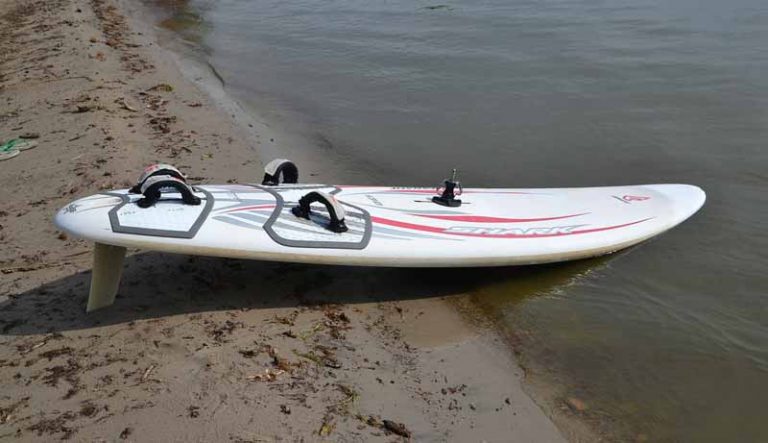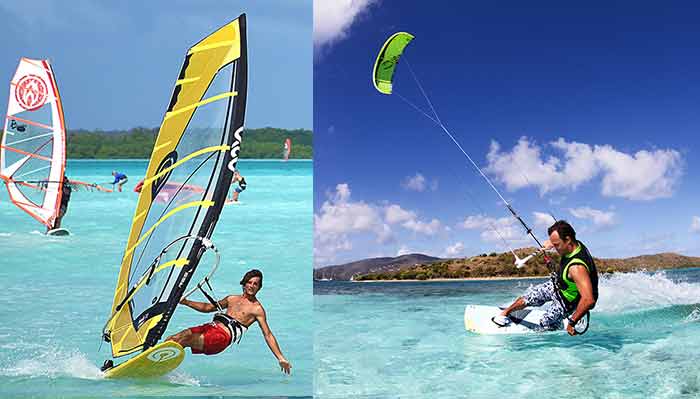What is Windsurfing? Origin, Equipment, Videos & Pictures
When talking of water surfing activities, the talk will not be complete without mentioning windsurfing. Though there are claims that it is a declining sport, a lot of people still practice and enjoy it. In fact, it is an activity that any water sports enthusiast will love to know more about.
Following is a breakdown of what windsurfing is, history of where it was invented and when it started, equipment/accessories/gear, variations or types of this sport plus videos and pictures
What is windsurfing?
Windsurfing is a recreational sport that is practiced on the surface of water that involves a sailor gliding across the water on a board rigged to a sail.
The board is powered across the water by the wind that acts on the sail. It actually brings together the elements of sailing and surfing.
Around the world, this activity is common in areas with huge bodies of flat water and wind, such as oceans, seas, lakes rivers and estuaries.
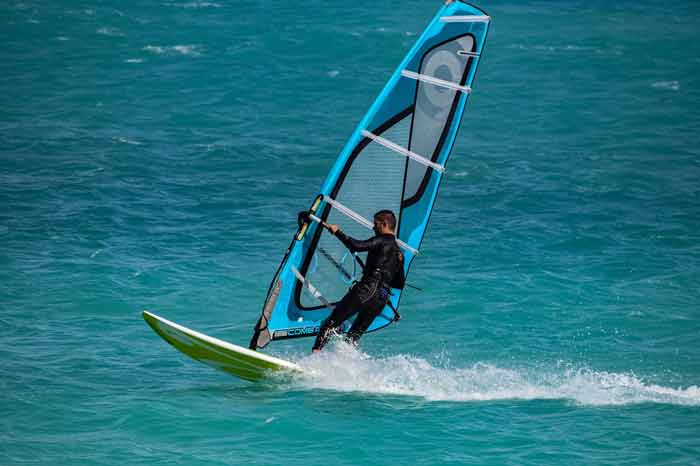
Where was windsurfing invented? History & Origin
Board sailing is dated back in the latter half of the 20th century. However, research shows that before this there were boats of various designs that were still propelled by wind with a vertical sail.
Basing on the available information, there seems to be a little debate on the place where windsurfing was invented. Most believe it was invented in England (Hayling Island) by Peter Chilvers. He is said to have built the first windsurfer in 1958
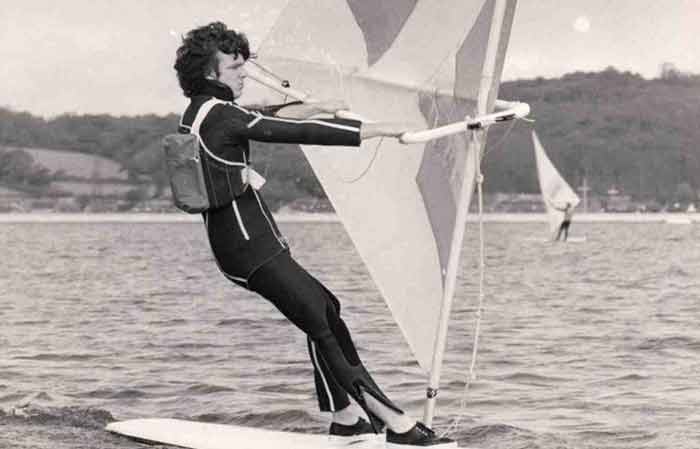
However, a number of individuals from different areas have come out saying they are the inventors.
In America, a 20-year old Newman Darby is said to have come up with the idea of using a sailboard in the year 1948. Stories published this year as reported by the International’s patent show that Darby invented the sailboards together with his wife Naomi in Wilkes- Bare, Pennsylvania.
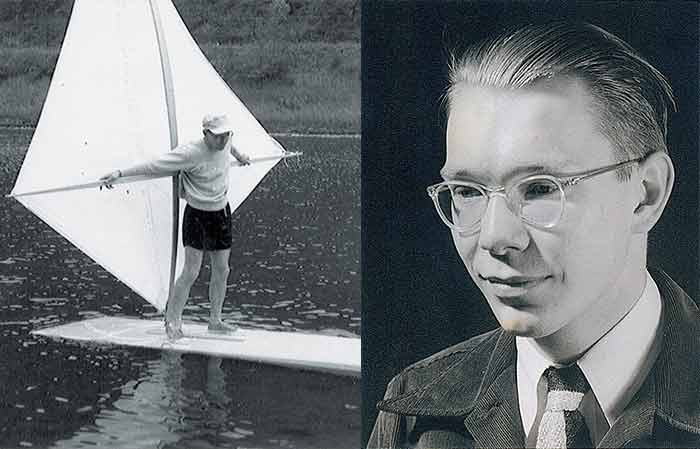
The sailboard was made using a handheld sail and a rig fixed on a universal joint. It was the first windsurfer that was propelled by shifting your body to balance the weight which eventually led to the movement of the sailboard.
Though, it is reported that he did not sell his sailboards until in the year 1964. By this time, he had already made the sailboard stable by fixing a conventional stayed loop rig. He is therefore believed to be the inventor and designer of the sailboard.[1]
Additionally, in 1960s, Aeronautical engineer Jim Drake solved a couple of problems looking forward to the functioning of the device. This involved addition of a rope that was used to get the sail out of water. He therefore named this design ‘Skate’.
In 1968, Jim Drake and Hoyle Schweitzer formed the windsurfing international company in the southern part of California which manufactured, promoted and licensed a windsurfer design. They therefore patented the design.

However, due to lack of knowledge of the impact such invention will have to the water sites, Drake sold this patent to Hoyle who sold it to the public hence became the first successful marketer of the board.

In the year 1984, windsurfing was taken in as Los Angeles Olympics where Dutchman Stephan emerged the winner and was the first person to be awarded the gold medal in the windsurfing category.
In 1970s and 1980s, the windsurfers were classified into short boards and long boards, a classification that seized as many designs of these boards emerged with new technologies and materials used.
Today, we have many categories of sailboards that can be classified into free ride, wave boards, formula windsurfing and freestyle boards among others.
Estimates made in the 1980s show that one out of three households had a windsurf board. These boards were made using the same design to make it easier for competitions.
Currently, the Olympic class used is Neil Pryde RS: X, which changed in 2008 and has been used from then. The International Sailing Federation in May 2012 decided to leave out the windsurfing competitions in 2016; however, due to numerous complaints from the windsurfing federations the decision was rewound.
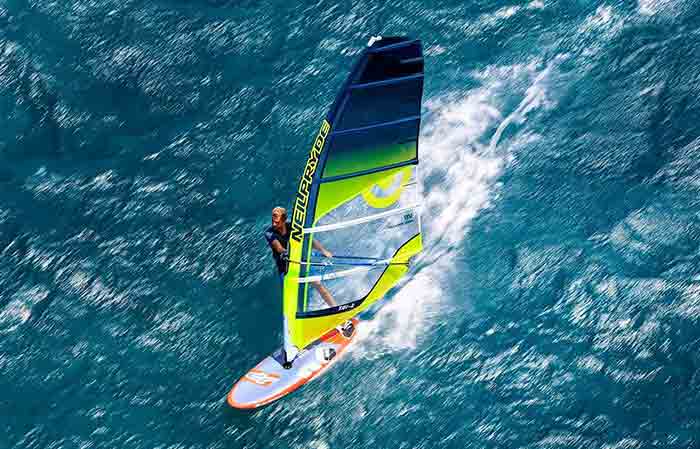
Today, boardsailing has emerged one of the best Olympic sports making it famous all around the world. Similarly, a couple of Olympic class windsurfing organizations have been formed giving the sport an excellent backup in Olympics.
Windsurfing Equipment
A surfing board and a rig are two main things you need. To these two, other accessories are attached.

Other accessories include;
- Helmet
- Wetsuit
- Harness
- Water shoes
- Sunglasses
- Rescue Jacket.
Surfing Board
This is the most important part of any windsurfer’s equipment. The surfboard is a long (2.5-3 meters) piece of board that provides a surface where you can stand. It also comes with one or more fins and dagger boards (on some models) underwater.
The boards are made of either Expanded Polystyrene Foam, Epoxy, Fiberglass, PVC or Carbon Sandwich. Lighter boards are good for Wave and Speed windsurfers
Dimensions of the sailing region depend on how skilled the sailor is, type of surfing involved as well as the sailor’s weight.
Further Reading: Windsurfing Boards, Parts & Types
The Rig
The rig is made up of a sail, mast, and a boom. While surfing, the boom is what you hold on to. The mast acts as a support. An uphaul is the cord that runs from the boom to the bottom of the mast, used to pull the sail up.
Helmet
It is worn for safety. It protects the sailor’s head from any injuries that may occur while windsurfing.
Wetsuit
It is a skintight outfit, made from foamed neoprene, that keeps warm and comfortable while in water. It also protects your skin from direct sunlight and scratches
Water Shoes
They keep surfers’ toes and feet free from scratches
Sunglasses
They shield your eyes from the direct sunlight as well as light reflected from water. Wearing sunglasses saves you from tiring the eyes due to light and winds.
Harness & Harness Lines
These are middle links to your sail and board that improve your windsurfing efficiency and extends your sailing sessions.
Why do people windsurf? (Overall Benefits)
You might be wondering whether windsurfing is of any great importance to your life. If you have been questioning yourself whether to start or not then the answer is yes as this sport not only earns you a trophy as a champion but also comes with a couple of health benefits.
Further Reading: How to windsurf for beginners
Great Health benefits
Most persons think that exercise involves only some activities such as jogging or playing in the field. However, windsurfing is a great event to undertake especially as a leisure activity as like any other sport it is also an excellent opportunity of achieving body fitness.
Besides exercise, there is a number of health benefits associated with boardsailing. These include the following;
Mental Fitness
This is highly associated with staying under sun while still on water as it helps absorb vitamin D which is essential for growth of the brain as it also suppresses depression leaving your brain relaxed and healthy.
Additionally, windsurfing enables you forget some of the terrible experiences in your life which leads to less stress. This brings more happiness in your life.
Staying under sun replenishes voluntary attention and develops brain connectivity for a better and efficient focus. However, it is important to put on plenty of sunscreen or shield to avoid damage of the eye retina due to much heat from the sun rays.
Body strengthening
When exercising, your muscles become stronger due to contraction and relaxation so as to provide much energy for the activity being undertaken. This is the case as you balance on the sail board since the whole body is used to operate the sail rig and steer.
Cardiovascular muscle endurance
These muscles become stronger which enhances blood flow in the body. This is usually as a result of oxygen demand on the other body muscles especially in the arms, legs and back which therefore enhances your body put out as you can work for a long time without getting fatigue.
Prevents obesity
Windsurfing reduces the number of calories in your body by burning the fat in the body tissues. Research reports that experts burn about 1000calories per hour whereas recreational person burn up to 500 calories.
Additionally, burning of body fat reduces risks of suffering from ailments such as hypertension. This eventually reduces cases of heart failure.
Further, windsurfing enables you have enough and good sleep at night. This is so since after the fun day, you will become tired and ready to rest.
Other benefits
These include socialization as you will meet new persons who have already developed and known the benefits of wind sailing. Having a new company with you will bring about more happiness in your life; a great way to avoid stress.
In addition to this, you will never get bored as you will always have a style in mind of trying the great experience. Direct interaction with the waters and waves, as well as visiting new places and coming across new nature will make the event more fun.
Wind boarding also helps build your self-respect. This is so as you become more confident and cooler as you go across the waters.
To add on this, it enables you learn about wind forecast and weather prediction. This occurs as you think or wait and predict for the time when the weather is cool or windy for sailing.
Moreover, this will increase the chances of your safety during the surfing period which eventually reduces risks of injuries.
Competition Types
Olympic Windsurfing Class (RS:X)
Olympic windsurfing class was developed in the year 2004 and produced 2005 by Jean Bouldoires. This was as a result of the successful bid by Neilpryde to supply one design windsurfing equipment to be used in 2008 Olympics in China. Generally, it was made to replace the Mistral One Design class.
The equipment comprised of a high-level technology rig with mast and boom and a wide style board that made it easier for the competitions to be held in any condition.[2]
Its stability provides a high concert locked in feel in planning conditions. However, it also performs in non-planning conditions due to its light weight and high performance.
RS: X allows for the participation of both men and women hence attracting the best windsurfers to the event.
Formula
This refers to a high concert racing competition with high range of wind which makes it possible to compete in winds from 7 to 35 knots unlike the Olympic class which operates in the range of 30 to 33 knots.
Wave sailing
Wave sailing is quite similar to freestyle, however; in this case, the water waves are involved in the movement. It comprises of wave jumping and wave riding.
In wave jumping, you jump from the peak of unbroken wave while doing both forward and backward rotations. On the other hand, in wave riding, you do a number of top turns and cutbacks and ride on unbroken wave back to the shore.
Freestyle
In this class of competition, the participants are judged according to their creativity based on the number of tricks they have and their ease of performance. If you execute tricks on both the port and starboard with full plan then you score higher marks.
Slalom
This refers to a high-speed race with two courses; Figure of weight and downwind. Normally, Slalom boards are tiny and narrow hence work best in conditions with high wind.
In figure of eight, the entire course on a beam is required to reach with two floating marks that have to be jibed around. On the other hand, in downwind, more than two marks are laid then you sail a downwind course, gibing around each mark once.
Speed Racing
Typically, speed sailing occurs in several forms where competitions are organized in several regions well known for good speed conditions. In this case, your best speed for every heat is obtained by finding the average of your best two heat speeds on a 500m course.
Here, the sailor with the highest score becomes the winner; winning is not based on how fast you are but rather how good you are in the heats (since your average determines your score).
Foil
Wind foiling is used in regions with less consistent wind for traditional short board. The enough wind pulls you up on the foil after which you generate enough wind to accelerate the foil to its full cruising speed normally about 20 knots.
However, research shows that there are wind foils that fly at an approximate speed of 30 knots. Although, for a beginner, you are advised to start at a lower speed of about 12-15 knots.
Super X
Generally, this class involves both slalom and freestyle methods. Here, you are required to race on a short downwind slalom course, perform all turns and use as many tricks as you can.
You are therefore advised to put on protective garments to prevent injuries. However, this type of windsurfing competition is no longer practiced since the year 2000.[3]
Tandem
Tandem windsurfing is basically two windsurfing sails that are fixed on one big board. This is normally made for two people.
You are highly recommended to use this type of windsurfing especially when you are a new sailor as it provides security in case of any dangers during the exercise. Moreover, it helps boost your skills faster than expected.
Indoor windsurfing
Indoor windsurfing involves shooting down the ramp in front of the crowds. In the case of sailing freely, you are advised to perform best of your tricks during the front movement then perform more tricks as you move backwards.
Amazing Windsurfing Videos
FAQs
Why is windsurfing dying?
There is a lot of info on the internet claiming that windsurfing is slowly resting in piece…somehow, it is the internet trying to kill this amazing aqua activity. Some say it is because it is expensive while others claim that other sports like windfoiling and kitesurfing are taking over.
The decline depends on where you live. It is true that in some places it may be declining while in other regions it steadily growing. It is in fact still an Olympic game.
Verified data from IWT (International Windsurfing Tour) indicates that, IWT Wave Riders had over 20 million views in 2019 across the IWT Facebook and IWT Instagram platforms alone.
At the end of the day it does not matter if the sport is dead or not, if windsurfing makes you feel good then honestly, there is no need to worry about who is or is not doing it. It is all about you.
Is windsurfing hard?
Compared to other surfing sports, it can take you some time to learn especially if you are a complete beginner. This basically because you have to combine two crafts: sailing and surfing.
However, with the right gear, instructor plus your dedication, you can learn it quickly. Nothing on this planet is hard as long you dedicate time and effort to learn and practice. If believe it is hard then probably it will be hard.


